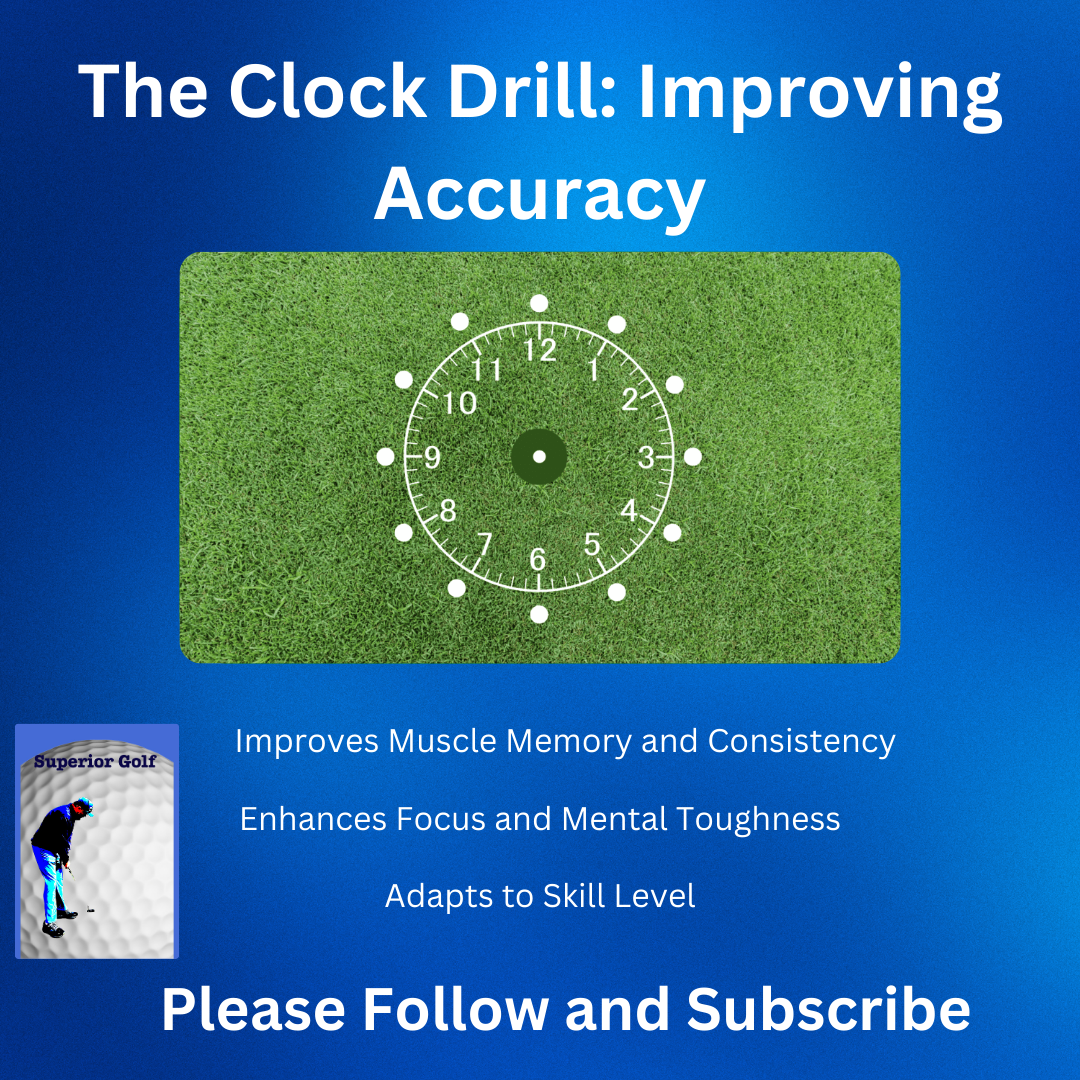The Clock Drill: Improving AccuracyOn the putting green, the outcome of your game can depend on just one putt. Golfers can relate to the nerves—heart pounding, hands sweaty, watching the ball roll toward its destination. Improving your putting can turn a good game into an outstanding one. The Clock Drill is a key method for sharpening your putting skills.
In my golf journey, I struggled with getting my putts just right. It changed when I started the Clock Drill. Taught by renowned instructor Maria Palozola, this technique helps focus on putting challenges.
The drill uses tees at different spots around the hole to practice. It improves your game by dealing with varying green conditions. Also, mastering this drill boosts your confidence and calms your nerves on the course.
Key Takeaways
- The Clock Drill builds consistency through repetitive practice from various distances.
- Maria Palozola, a leading instructor, advocates for structured practice methods like the Clock Drill1.
- This drill helps reduce putting anxiety, providing a calmer mindset during real games2.
- Using tees to simulate different green conditions ensures preparedness for any putting scenario2.
- Implementing the Clock Drill in practice routines can significantly improve golf accuracy and performance.
Understanding the Clock Drill
The Clock Drill uses a circle of targets or golf balls, like a clock face. Shooters must find the right “time” or target after turning around. Golfers put tees around the cup to match clock numbers. They putt from each spot, handling breaks and slopes. This helps them make flawless shots from near to far distances23.
It’s a key drill for golfers, teaching them to adjust their focus and shots3. This drill sharpens physical skills and mental toughness under pressure. It also lets golfers see their growth and set tougher challenges as they improve2.
In both shooting and golf, precision is crucial. Golf expert Maria Palozola stands by the Clock Drill for its boost to consistency and recall1. It’s proven in training, linked to over 127 putting stats1.
Beginners should start with four balls at each distance, then add more as they get better2. This technique feels like real competition, building confidence in short putts2. The Clock Drill is not just practice; it’s a total approach to nailing accuracy and upping your game in precision sports.
Benefits of the Clock Drill
The Clock Drill is a great way to sharpen your golf putting skills. It’s especially good for making short putts consistent and accurate. It helps with physical skills and mental strength.
Improves Muscle Memory and Consistency
One big plus of the Clock Drill is it boosts muscle memory. Golfers putt from 3, 5, 7, and 9 feet away, improving their stroke under different conditions. This leads to better muscle memory and more consistent play3. By practicing at these distances, golfers get better at putting. This makes their gameplay more reliable and sharp.
Enhances Focus and Mental Toughness
The Clock Drill also ups your focus and mental game. It puts you in all sorts of angles and distances, making you deal with pressure. Golfers are pushed to keep their focus and stay cool under stress. When missing a putt means starting over, they learn to handle the tension. This builds confidence and smart thinking3.
Adapts to Skill Level
Finally, the Clock Drill works for all levels of golfers. It’s easy to make harder or easier, fitting everyone’s needs. New players can start close and move back as they get better. This drill boosts your skills, especially in handling different slopes and breaks3. It’s great for anyone looking to get better at putting.
Implementing the Clock Drill in Your Practice Routine
Adding the Clock Drill to your practice is vital for better putting and golf skills. It works well for both new and experienced players. It’s designed to make you a better golfer.
Setting Up the Drill
To set up the clock drill, place tees around the hole at 3, 6, and 9 feet. They should look like a clock’s numerals4. This setup imitates real game scenarios, letting players practice from different spots5. Since putting makes up about 40% of the game, practicing well is crucial6.
Steps and Techniques
The steps to master the clock drill are simple but need focus and regular effort:
- Positioning: Put golf balls or markers around the hole like a clock face4. It’s key for practicing shots from various angles, which sharpens your putting.
- Putting: Putt systematically, starting close and moving outward4. It helps with controlling distance and hitting the ball accurately5.
- Alignment: Keep a straight, consistent putting stroke6. Correctly align your putter and eyes over the ball for better shots.
- Consistency: Do the drill often to get better. Increase the challenge as you improve, for more precision65.
Drills like the Gate Drill and Two-Tee Drill also enhance the clock drill, offering a comprehensive practice session45. They help in fine-tuning your putting skills, and better alignment and rhythm6.
By following these steps and regularly doing different golf drills, your putting and overall golf skills will greatly improve.
Conclusion
The Clock Drill is a top choice for boosting golf skills. It helps with aim and putt sharpness. By practicing regularly, golfers can hit the ball just right, mastering speed, alignment, and how far it goes. This is key for both newbies and pros7. Golfers get better at short putts and feel more sure of themselves. They learn to deal with different layouts and challenges on the green8.
This drill is similar to practice methods in other sports like basketball and hockey. For example, basketball players use the Step Slide to get better at moving side to side and handling the ball. This is kind of like how the Clock Drill boosts putting moves through the same motions again and again9. Hockey players work on their game with drills that improve how they stand and work as a team. The Clock Drill does something similar for golfers, focusing on strategy and teamwork10.
Adding the Clock Drill to your training can really up your game. It’s like other sports where practice makes perfect, gradually getting tougher to keep you growing. This isn’t just a routine; it’s a cornerstone for those who want to be the best under pressure and wow everyone with their skill710.
FAQ
What is the Clock Drill?
How does the Clock Drill benefit golfers?
How can shooters apply the Clock Drill in their training?
What are the steps for setting up the Clock Drill in golf?
What techniques are essential for mastering the Clock Drill?
How does the Clock Drill enhance muscle memory and consistency?
Can the Clock Drill be adapted to different skill levels?
What is the importance of mental toughness in the Clock Drill?
What’s the best way to integrate the Clock Drill into a practice routine?
Source Links
- https://www.mygolfinstructor.com/instruction/putting/drills/clock-drill/19/
- https://www.puttimprover.com/en/blog/detail/37/putting-exercise:-the-clock-drill.html
- https://golfselections.com/blog/The-Clock-Putting-Drill
- https://nationalgcla.com/10-golf-drills-to-improve-your-game/
- https://migolfmatrix.com/improve-your-skills-with-these-putting-practice-drills/
- https://primeputt.com/blogs/golf/best-indoor-putting-drills
- https://www.golfzonleadbetter.com/blogs/master-your-putting-game-6-effective-putting-drills-for-precision-speed-alignment/
- https://www.thelinksatirelandgrove.com/practice-putting
- https://teachhoops.com/5-dynamic-basketball-warm-up-drills/
- https://fastercapital.com/topics/conclusion-and-practice-drills-for-penalty-kill-improvement.html

